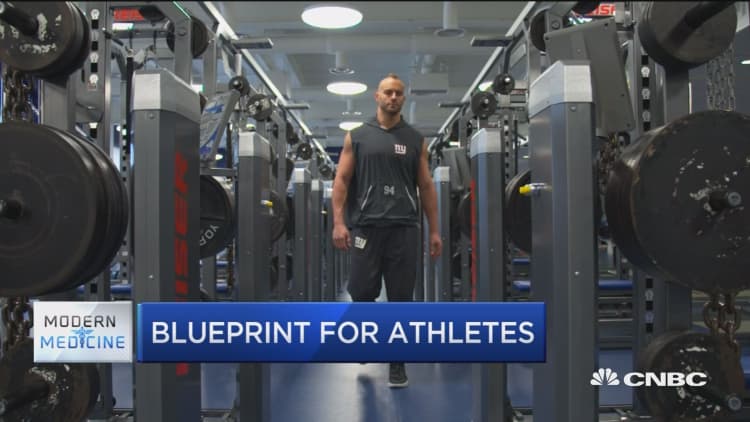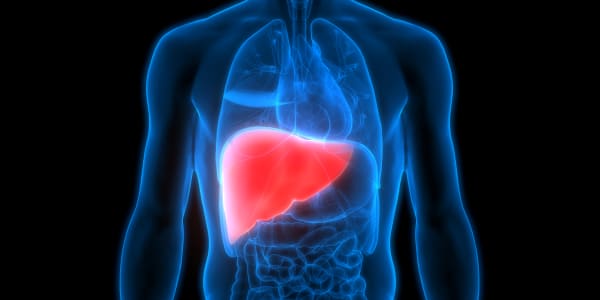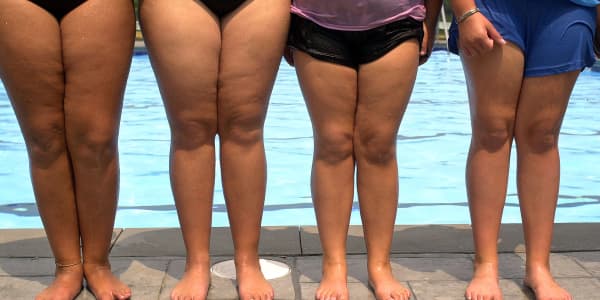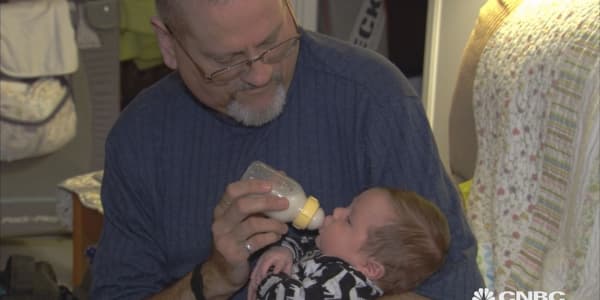
I never thought I'd have anything in common with an NFL linebacker.
But it turns out, with the New York Giants' Mark Herzlich, I have at least two: We both love peanut butter and jelly sandwiches (but who doesn't?) and we've both taken Quest Diagnostics' Blueprint for Athletes blood test.
"It's based on four checkups through the season," Herzlich told CNBC, "to see where our blood levels are, what the changes are, and to correlate them on the schedule."
For me, it was for a story (this story). Quest, the lab-testing giant, has offered the Blueprint for Athletes tests since 2013. The test examines dozens of markers in the blood, from glucose levels to blood cell counts to "muscle status" markers, like creatine kinase. It also measures food sensitivities, which is where PB&J's come in.
"I had been eating PB&J sandwiches before every game since I was 10 years old," Herzlich said. His first Blueprint test, though, revealed a sensitivity to peanuts. "I cut peanuts out of my diet and I noticed a real surge in energy later in the games."
Beyond a partnership with the Giants, Quest also works with college sports teams. And increasingly, it's seeking to market the Blueprint test to amateur athletes in a movement beyond wearable fitness trackers.
"Athletes spend a tremendous amount of time and money to pursue their sport," said Richard Schwabacher, Quest's executive director of sports science and human performance diagnostics. "Ironman athletes can spend up to $12,000 in any given season between their bike, pool and coaching."
The Blueprint for Athletes tests cost $150 to $400, depending on how much the athlete wants to look at.
"We think a couple hundred dollars to make sure that everything they are doing is helping them, not hindering them, makes a lot of sense," Schwabacher said.
For the Giants, the tests influence training and nutrition schedules, according to head athletic trainer Ronnie Barnes.
"We look at creatine kinase, which tells us about the players and fatigue; we're interested in hydration, and we're able to get that information from the reports," Barnes told CNBC. "As a result of the data we collected, we have been able to advise the coaches about length of practice, breaks during practice and practice duration."
So what about me? For the record, I'm not an elite athlete. But for the last couple years, I have been a guinea pig for the increasing number of direct-to-consumer testing services offered by companies like Illumina and 23andMe (See those results here and here.)
The major difference between those tests and Quest's, of course, is that Illumina and 23andMe are testing genes, while Quest is testing levels of different markers in the blood. There are newer services like Arivale's "wellness" test, which combines the two, and adds information about the gut microbiome to boot (I haven't tried that yet, but rest assured, I will).
And a key question about all of these tests is: How useful are they? It's fun to see the results, but do they actually change anything?
I decided to take my Blueprint results to Dr. Dennis Cardone, a sports medicine specialist and associate professor in the Department of Orthopedic Surgery at NYU Langone Medical Center. Cardone is the head team physician for athletic programs at NYU and Long Island University and is a team physician for the U.S. Open tennis tournament.
His take?
The results are "probably not that useful," he told me. "Most important, no doubt, is a good, sound nutritional program and a good program of exercise and training."
OK then. But my results did turn up a couple interesting things. First, I've got a pretty pronounced Vitamin D deficiency. And I don't get enough Omega 3s. And I was a bit dehydrated the morning my blood was drawn.
"There is a significant amount of the population that is deficient in Vitamin D," Cardone told me. He says most people could probably add 1,000 to 2,000 international units daily to supplement their diets anyway. And I already knew I don't eat enough healthful fish or drink enough water. But it's good to have a reminder.
I'm not the target for a test like Blueprint for Athletes. I was just happy to know I was basically within normal range for almost everything. But for someone competing on a semi-professional or professional level, it's not about "normal," Rutgers associate professor Shawn Arent said.
"The difference is 'sufficient' versus 'optimal,'" the director of Rutgers' Center for Health and Human Performance told me. "That's where we have the biggest debate between exercise physiologists and physicians: Yes, enough, but enough for what?"
Arent works with the school's women's soccer team, and previously was a physiologist for professional sports teams, including the New Jersey Devils. He has a research agreement with Quest and serves as a board member for Blueprint. And he says the test is most important for tracking changes over time.
"Where people sort of make the mistake with this is they get their baseline and everything's fine, and they're like, 'That didn't tell me anything,'" Arent said. "Well, yeah it did. It told you your starting point."
For the Giants' Herzlich, the test gives him more than insights into his training and nutrition. In 2009, while he was playing for Boston College, Herzlich was diagnosed with Ewing's sarcoma, a rare bone cancer. It left him with a titanium rod in his leg.
He's now cancer free, and says the frequent blood tests as a routine part of his training help set his mind at ease.
"When I was going through chemo, we always looked at my blood cell counts," Herzlich said. "This is an incredible way to monitor those things without going to the hospital every month. If there is an issue with any of my levels, I get my information from the Blueprint for Athletes report and I call my oncologist."
Luckily, Herzlich says, he hasn't seen anything serious. He did, however, have to give up his pregame PB&J's. And as for me, I added a daily vitamin D supplement.




